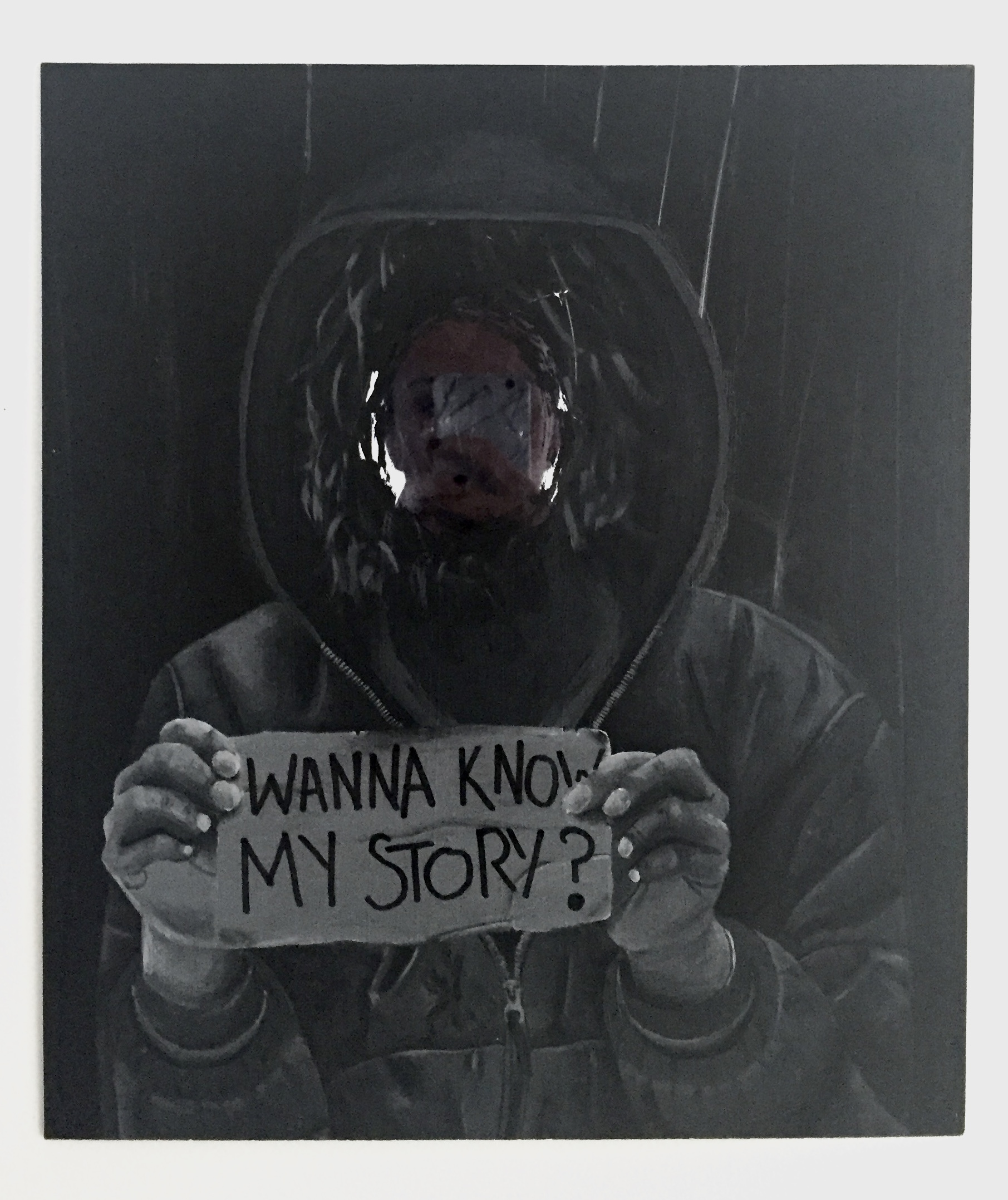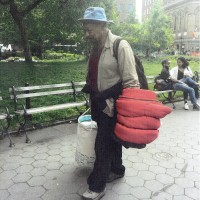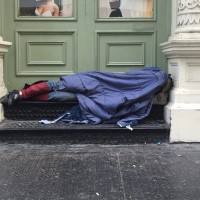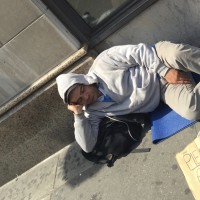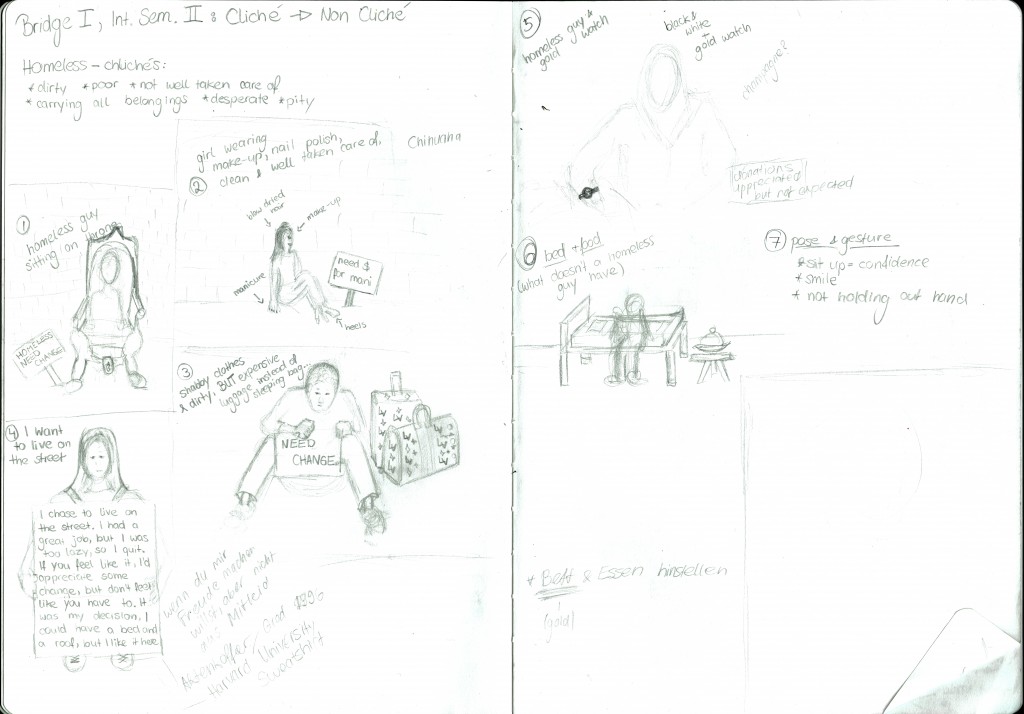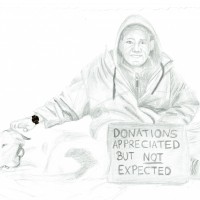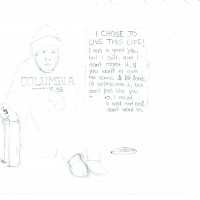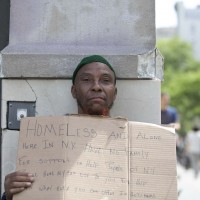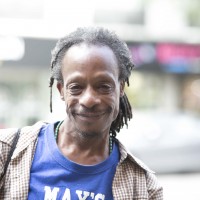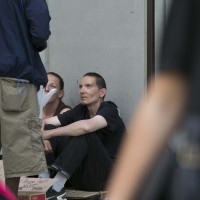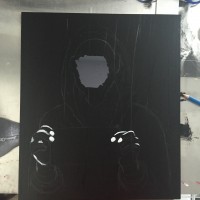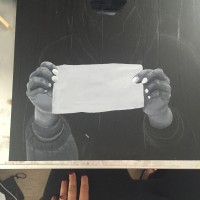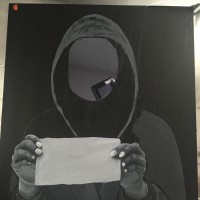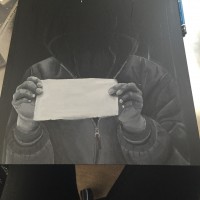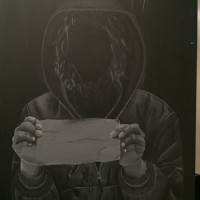For the Uncliché project, I chose to work with an image of a homeless guy, carrying his sleeping bag in one hand and all his belongings in the other. The picture was taken at Washington Square Park. I chose to work with homelessness, because I saw it as one of the more challenging topics and wanted to test myself. Especially in New York, homeless people sitting on the sidewalks have become a huge cliché, because we are so overexposed by them. I would say there is an average of one homeless guy per block, which would add up to hundreds in New York. All of them look miserable and evoke pity in us people walking by, which is why we reach out to them to try and help them. But how can we change this?
To start of the project, I walked around New York and looked for more homeless people that I could sneakily take a picture of. I tried to look at similarities and differences in the individual homeless guys, seeing what it was that made me pity them, and how I emotionally reacted to them. The homeless guy in the second picture, for example, is sleeping on top of a Gucci designer bag, which I thought was very ironic.
Using the inspiration I had gotten from looking at these guys, I started sketching out some of my ideas. I had three main concepts which were: 1) portray them with something they are stereotypically known not to have (money, food, a roof, a bed…) 2) try to eliminate the difference in class we feel when walking past the homeless guys, so that we do not look down on them but see them as one of us 3) in Germany, many homeless people choose to live on the street, rather than fate choosing this life for them. The social system would provide them with help to get off the street, but many choose to rebel against this system.
From my first sketches, I chose two ideas to further explore. In one of my drafts, I tried to present a homeless guy with something he shouldn’t have, in this case a gold watch. Esthetically, I really liked the contrast between the pencil sketch and the gold watch. However, I was not happy with the message it put across at all, because it was away too easy and was unclichéing something with an even bigger cliché. For my second draft, I tried putting across the idea of people choosing to live on the street, of choosing to quit their old life to commit to the lifestyle of living on the street. While I feel this might have worked well in Germany, I think it is a little out of context here in the United States. Here, most people do not decide to live on the streets, but are doomed to. I didnt want to disrespect this by claiming it’s their fault they live on the streets, so I decided to discard this idea too.
- Draft 1
- Draft 2
As I wasn’t really happy with either of the two drafts I made, I kept thinking about the whole concept of homeless people a little more. For me, it is the pity I feel towards them that really makes me differentiate between them and me. How could I realistically take away this pity and present a homeless as “one of us”? I think simple things such as body language and facial expression are essential elements of this. When studying the homeless on the streets of New York, I realized that I felt different towards homeless people that were smiling at people walking past, than to the ones that looked miserable. My cliché image of a homeless person is someone sitting on the floor with no confidence whatsoever, looking like a picture of misery, desperately holding out a hand, begging for our pity and help. To turn this around, I thought it would be interesting to have homeless people pose with confidence, to have them stand up to be on our eye level, confidently leaning against a wall, their hands either in their pockets or crossed over their body, turning them away from the people walking past, in order not to cause their pity. I wanted them to look happy, rather than exhausted and lonely. I tried shooting some photos with the help of Moran to bring across that idea. However, most of the homeless people weren’t really cooperative, and felt rather humiliated by us asking for their photo. It just felt unnatural to put them into those photos, as well as wrong and disrespectful to have them do something they clearly did not want to. While I still liked the concept of it, I wasn’t sure how to present it without using photos of actual homeless people.
Thinking about other ways to make the viewer not pity a homeless person, I couldn’t stop thinking about bringing across the point that it could be anyone of us sitting there instead. When looking at them, we always think about their misery, rather than the life they had before and how they got to where they are. To show that it could hit anyone of us, I thought about drawing or printing a homeless guy onto a mirror, leaving out the face. When looking at it, the viewer will now be able to see his or her face in the homeless guy’s head. Ideally, I would like to have a series of 3, each one with different signs and different outfits, maybe one of them a woman. However, since this is only a one week long project, I am not sure how realizable this is for me if I go with drawing/painting, because it’s a medium I’m not that comfortable with and used to.
Process
Final Drawing
Looking at the final outcome of the painting, I am personally really happy with it, especially because this is my second representation; acrylic drawing I’ve ever done, and my first one of a person. I think the lower part of the image is very well done, but the upper part, the neck and the hair, could definitely be worked on. I really wanted to work on that part a little more before putting it up for critique in class, but I completely ran out of time. I spent too much time shading the jacket, to really work on the neck and the hair. This is especially a shame because I feel like the neck and the hair could add a lot to the homeless image. Getting this homeless idea across is extremely hard when not showing the face, because it usually is the face with all its wrinkles that really portrays their exhaustion. On the other hand, however, I also really like that he does not look as old, exhausted and dirty, as it makes identifying with him much easier.
I decided him to present him the way I did, only the upper body part and not the whole body because I wanted to keep the focus on the face. If I would have decided to portray the whole body, the face would have gotten a lot smaller, and would have therefore lost its position as the focal point of the image. I furthermore did not want the homeless to be sitting, as I wanted to keep up the idea of posture and the viewer not literally looking down at him when walking past. However, I think having him standing, leaning against a wall, would have taken even more from the image of a homeless guy, and would have made it even harder to understand the context of it. While the hood he is wearing could also be associated with a gangster and could therefore lead the viewer into the wrong direction, I decided to draw it because for me it is a symbol of hiding. Most homeless people aren’t proud to be where they are, they’re not confident and they are not happy with their situation. They want to cover up their dirty and messy hair, want to try to hide a part of their face.
For the materials, I chose to work with acrylics on black mirrored plexi glass. I decided to go with black mirrored plexi because plexi is not as reflective as glass mirror. Additionally, it comes in many different colors. As I wanted the mirror to be a part of the composition, I chose to go with the black mirror rather than a silver one. However, I think it could still be darker and less reflective, to make the image of the viewer a little more subtle. I could try to achieve this by coating the mirror with acrylic gloss mixed with a little bit of black acrylic paint.
As I mentioned above already, I would love to keep working on this drawing. When I put it up, I realized that the background wasn’t perfectly covered and there was still a little mirror looking through, which I think is very distracting. Furthermore, I want to see how it looks if I keep working on the neck and the hair, trying to make him look more “homeless.” However, I am not sure if that would really be the look that I’m going for, so it is something I want to try rather than definitely do.
